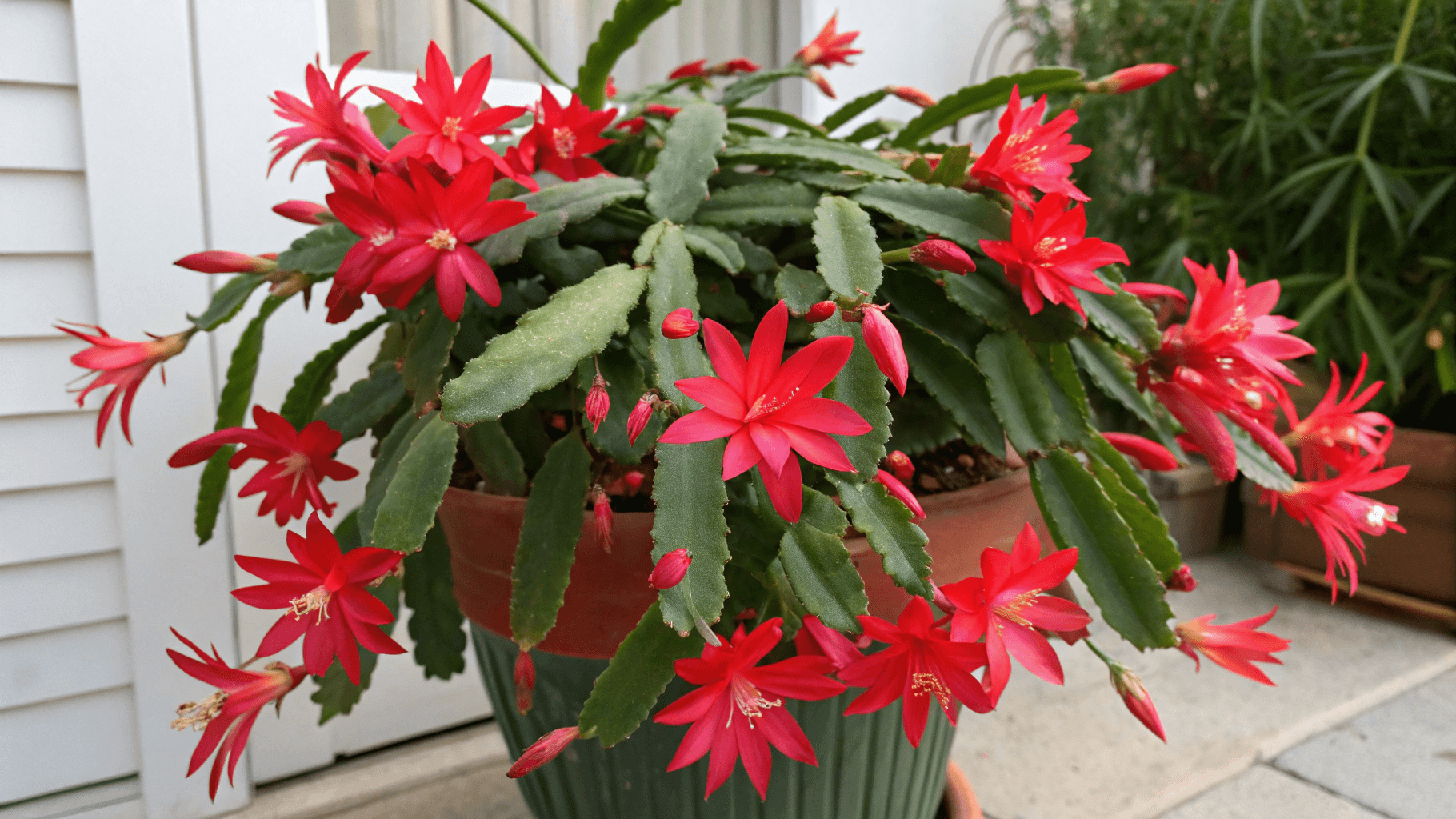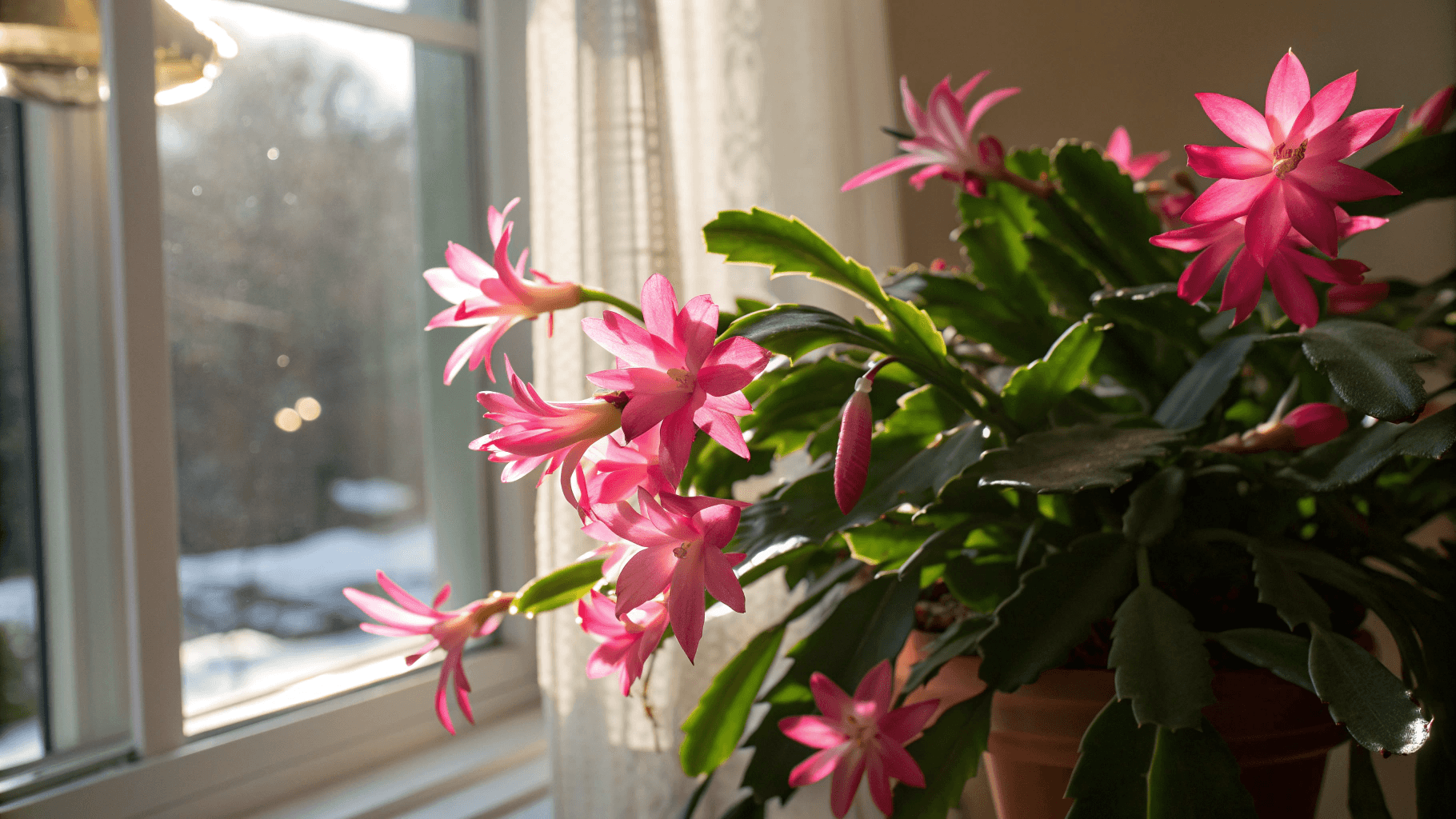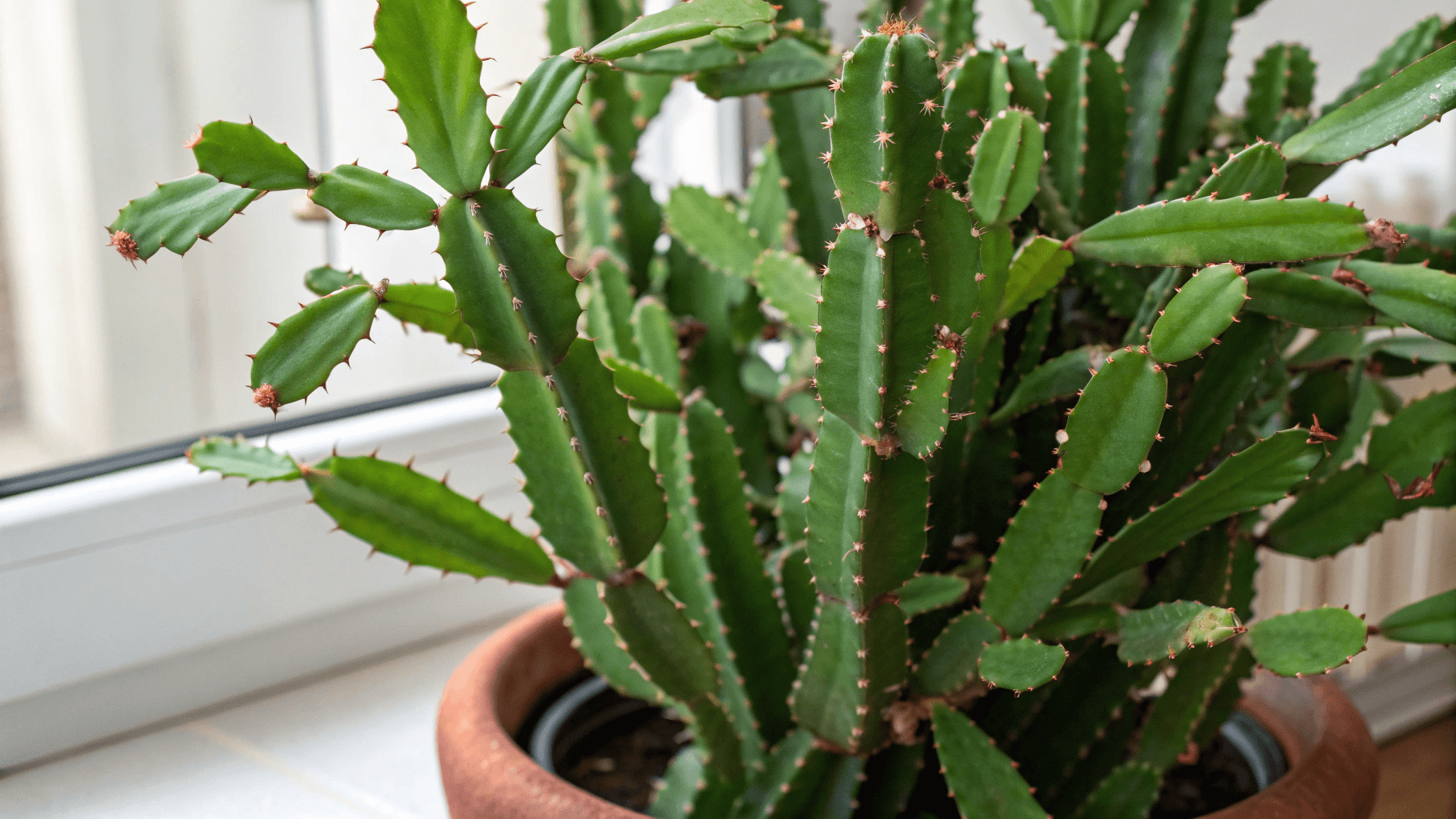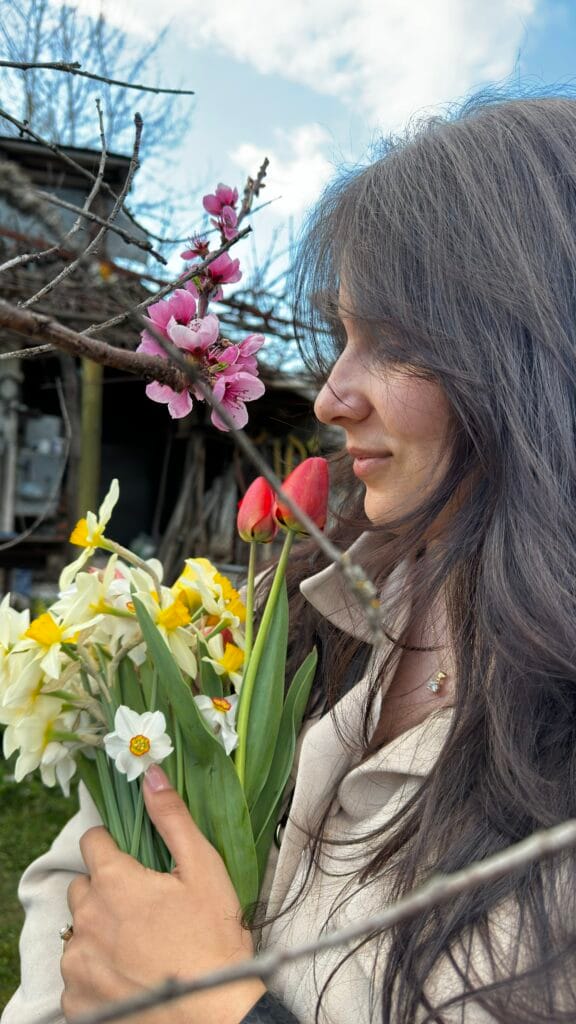How to make Christmas Cactus Bloom is a question many plant lovers ask every year. Your Christmas cactus needs the right combination of light, temperature, and a proper rest period to form buds and produce those stunning winter flowers.
A Christmas cactus that isn’t blooming is almost always reacting to a few simple care issues. Too much light, warm nights, or inconsistent care can stop it from blooming, but with a few simple adjustments, you can fix the problem and encourage fresh buds within weeks.
Common Problems and How to Make Christmas Cactus Bloom
Many plant lovers assume that Christmas cactus (Schlumbergera) blooms naturally every winter by default. So when November rolls around and your plant is sitting there with nothing but flat green segments, it’s frustrating and confusing.
Some of the most common blooming complaints include:
- “It grew new segments instead of flowers.”
- “It had buds, but they all dropped off.”
- “It bloomed last year, but not this year.”
- “It only blooms on one side.”
- “It used to bloom at my grandma’s house; why not at mine?”
The answer almost always comes down to a handful of environmental cues: light, darkness, temperature, and stress levels. Once you understand the Christmas cactus bloom cycle, troubleshooting becomes much easier.
Christmas Cactus Bloom Cycle Explained

Christmas cacti don’t bloom randomly. They follow a natural cycle triggered by:
- Shorter days
- Longer nights
- Cooler temperatures
- A brief rest period before budding
Unlike desert cacti, Christmas cacti are tropical epiphytes native to Brazilian rainforests. They aren’t used to blistering heat or months of drought. Instead, they experience moist, filtered light and seasonal shifts in day length. Their blooming period naturally lines up with late fall and early winter in the Southern Hemisphere.
The Bloom Cycle
- Spring and Summer – Growth Phase
The plant focuses on producing new segments. Good fertilizer and bright shade help it grow. - Late Summer – Rest Period
The cactus needs slightly less water and mild stress to prepare for budding. - Fall – Bud-Setting Phase
Triggered by long nights and cool temperatures (55-60°F / 13-15°C), the plant begins forming little buds at the ends of its stems. - Winter – Blooming Phase
Once buds appear, the plant needs stable conditions to open fully.
If any of these stages are disrupted – too much light, warm nights, inconsistent watering- the plant may refuse to bloom.
Light Requirements for Bud Formation

Light is one of the most misunderstood blooming factors. Christmas cacti aren’t low-light plants; they prefer bright, indirect light most of the year. But when it comes to forming buds, the pattern of light matters more than brightness.
What the Plant Actually Needs
- Bright indirect light from morning to afternoon.
- Long, uninterrupted darkness for at least six weeks before bloom time.
If the plant receives light after sunset, especially from overhead lamps, TV screens, or streetlights, its internal clock resets. This tells the plant it’s still “summer,” and the blooming trigger never activates.
Signs Your Cactus Is Getting the Wrong Light
- No new buds forming
- Lots of new leafy segments instead of flowers
- Buds start, then fall off
- Only the side facing darker conditions forms blooms
Simple Fix
Place your plant in a room that stays naturally dark at night, such as:
- A guest room
- A laundry room
- A room with no bright evening lights
Even one hour of bright artificial light during the night can interfere with bud development.
Temperature Requirements (Critical!)
Temperature is just as important, sometimes even more. Christmas cacti form buds only when exposed to cool nights.
Ideal Bud-Forming Temperatures
- Night: 55-60°F (13-15°C)
- Day: 65-70°F (18-21°C)
Warm nights above 70°F (21°C) prevent bud formation entirely.
Many people unknowingly keep their plant in the warmest room in the house, often the kitchen or living room. Unfortunately, those cozy indoor temps are the exact opposite of what your cactus wants during bud season.
Easy Temperature Tricks
- Move the plant to a porch or patio (as long as temps stay above 50°F / 10°C).
- Place it near but not directly against a cool window.
- Keep it away from heaters or vents.
A few weeks of cool nights can make a dramatic difference.
Day-Length (Photoperiod)
The Christmas cactus is a short-day plant, meaning it blooms when daylight hours drop below a certain threshold. You can use this to your advantage.
The Photoperiod Formula
Expose the plant to:
- 14 hours of complete darkness
- 10 hours of light
Continue this daily cycle for at least four to six weeks.
This technique is similar to how poinsettias are forced to color up for the holidays, and it works incredibly well for Christmas cactus.
How to Do It at Home
- Move the plant to a dark closet at 6 p.m.
- Take it out again at 8 a.m.
- Do this every day until buds become visible.
Or place the plant in a naturally dark room with no evening lights, it’s easier and more consistent.
Feeding Schedule
Fertilizer won’t “force” blooms on its own, but the right feeding schedule supports strong bud development. The key is feeding at the correct time of year and avoiding fertilizer when the plant is resting.
Spring-Summer (growth phase):
- Apply a balanced fertilizer (10-10-10 or similar)
- Feed every 2-4 weeks
This supports healthy leaf segment development.
Late Summer (resting phase):
- Stop feeding entirely
- Reduce watering slightly
This drop in nutrients primes the plant for budding.
Fall (bud-setting phase):
- Resume feeding lightly with a bloom booster, ideally something like:
- 0-10-10
- 5-10-10
Focus on higher phosphorus and potassium, which encourage flowering.
Signs of Over-Fertilizing
- Yellowing leaf segments
- Soft, mushy growth
- No blooms despite good lighting and temperature

If this happens, flush the soil with clean water and skip feedings for a few weeks.
7 Stress Factors That Prevent Blooms
Even if you get the light and temperature right, other stressors can sabotage blooming. Christmas cacti can be surprisingly picky when setting buds.
1. Overwatering: Soggy soil causes root stress, which can halt bud formation.
Fix: Water only when the top 1-2 inches of soil feel dry.
2. Underwatering: During the bud-forming stage, too little water causes buds to shrivel or drop.
3. Moving the Plant: Once buds appear, do not rotate or relocate the plant. Christmas cacti memorize light position and easily drop buds when moved.
4. Drafts: Cold gusts from doors or hot air from vents can shock the plant.
5. Dry Indoor Air: Heaters dry out the air, leading to shriveled buds. A humidifier or pebble tray helps.
6. Wrong Soil: Heavy, dense soil suffocates roots. Christmas cacti prefer light, airy mixes.
7. Pests: Fungus gnats, mealybugs, and spider mites can affect nutrient uptake.
How to Restart Blooming Next Year
If your plant missed its chance this year, don’t worry. You can reset its rhythm and encourage reliable blooming every winter. Here’s a simple yearly schedule that works beautifully:
Spring
- Repot if root-bound.
- Start feeding with balanced fertilizer.
- Keep in bright, indirect light.
Summer
- Move it outdoors to a shaded patio if possible.
- Water regularly but avoid overwatering.
Late August to September
- Reduce watering slightly.
- Stop feeding.
- Begin exposing the plant to cooler nights.
October
- Start the 14-hour darkness routine if natural daylight isn’t enough.
- Keep nights cool.
November
- Buds should begin forming.
- Once they appear, stop moving the plant.
December
- Enjoy full winter blooms!
- Keep soil moderately moist and avoid drafts.
Conclusion
A Christmas cactus that won’t bloom is almost always reacting to small environmental signals, nothing more. By giving it the right combination of long nights, cool temperatures, bright days, and a proper rest period, you can encourage it to produce those stunning winter blooms year after year.
With the right care, your Christmas cactus will reward you with the kind of flowering display that becomes a yearly tradition and a beautiful reminder that even the quietest plants have their own rhythm and timing.


 ChatGPT
ChatGPT
 Perplexity
Perplexity
 Claude
Claude

Leave a Reply